The Polish chicken has long been a favorite among eccentric owners of feathery fowl. It has a unique crest with feathers all around its head that makes a large tuft that can block its vision but makes it appealing and unique. They look like royalty.
The Polish breed is an ornamental fowl. It is a great bird for showing but not usually chosen for egg production. It will not work well as a meat bird because it tends to be lean and stringy.
However, if you are interested in raising chickens, want some eggs, and are looking for a great starter bird, the Polish chicken is a good choice. Note, other chicken breeds tend to dominate Polish chickens so keeping them with other easygoing breeds is important.
They do well in dry and warm climates.
While it can have some health issues, the Polish is friendly and will be comfortable in a backyard or garden environment. Just remember it’s an excellent jumper and escape artist, so having some chicken wire will keep them secure.
See below for the video of my Polish chicken. Her name is Trixie, and she’s friendly and full of personality.
Polish Chicken ~ Important Facts
Here are some of the key things you need to know about the breed before deciding to raise them:
Egg Production and Breeding
One downside to owning this kind of chicken is its breeding and egg production is widely variable and inconsistent. They are considered to be decent egg layers; however, people don’t usually raise them for their egg production. In addition, they have poor mothering instincts.
They can produce 150 – 200 eggs a year. Their eggs are medium-to-large in size. The egg shells are white. They don’t have specks or rounded edges. They look like standard chicken eggs.
Polish chickens are non-sitters. Breeding-wise, the Polish hens are rarely broody, so they are not great breeders. Similarly, they do not have the best parenting abilities, so they are not used for heavy-duty breeding or caring for the chicks of other animals.
Appearance
Polish chickens are one of the easiest to identify. The hen has a unique crest, giving them a regal look. These puffy head feathers can look like pom poms. Sometimes they look wild. This poof is known as a crest or a topknot.
The feathers of both biological sexes are known for growing straight up and cascading over the head and face, which can cause vision and grooming problems. The head crest is noticeable and has a bony prominence at the top of the skull.
Some variations of this chicken will be bearded and have profusions and tufts of feathers around the entire head and face, while a Polish rooster will have a red V-shaped comb.
- Chicken’s earlobes – Bright white
- Wattles – Bright red
- Legs – Gray
- Toes – Four toes on each foot
There should be no feathering on the feet. The plumage of the chicken can vary in color based on the variation of your flock. Their tail feathers are upright.
The skin should always be white, and the males and females can range in size from 4 – 6 pounds.
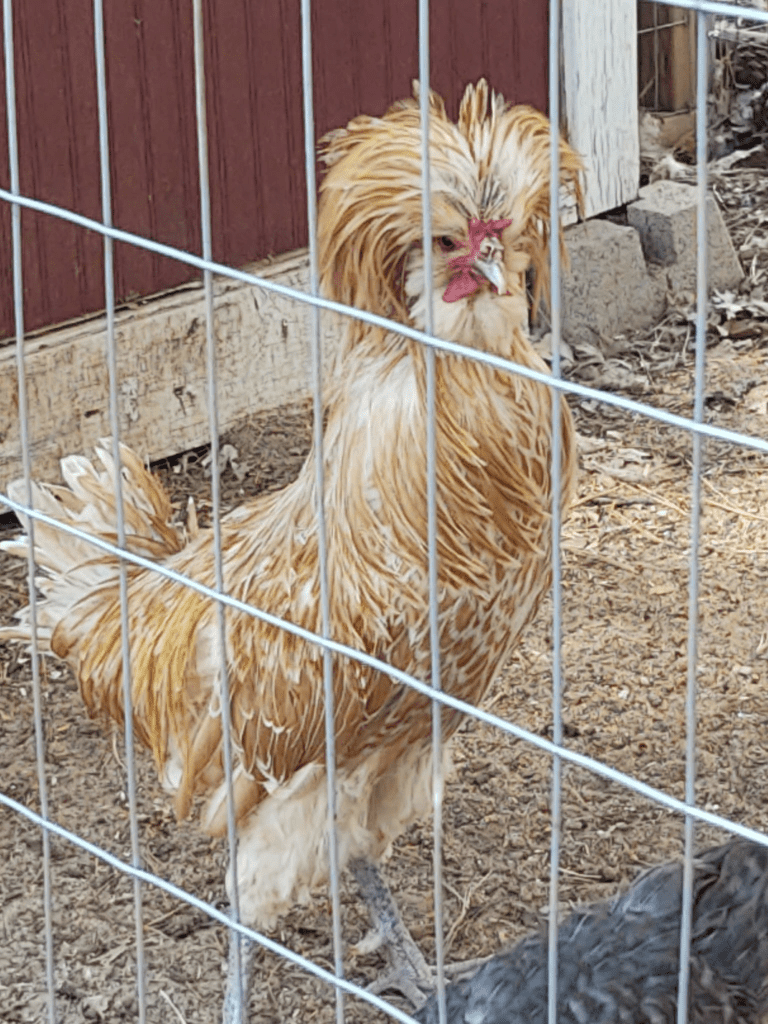
Polish Chicken Varieties and Breeds
As mentioned earlier, there are numerous varieties and breeds currently recognized by the American Poultry Association. The Polish breed of chicken can come in standard and bantam sizes and classified as a Continental breed because of its size and origins.
The recognized varieties include:
- Non-Bearded White
- Non-Bearded Silver
- Bearded Buff Laced
- Bearded Golden
- Non-Bearded Golden
- Non-Bearded White Crested
- Bearded Silver
- Bearded White
- Non-Bearded Black Crested
- Non-Bearded Buff Laced
The coloration of the plumage will vary significantly from white to silver, and from gold to black and many colors in between. With that in mind, your chosen variety will have little effect on the taste or behavior of the chicken.
There are also Polish frizzle chickens. Another variety of frizzle are cochin chickens.
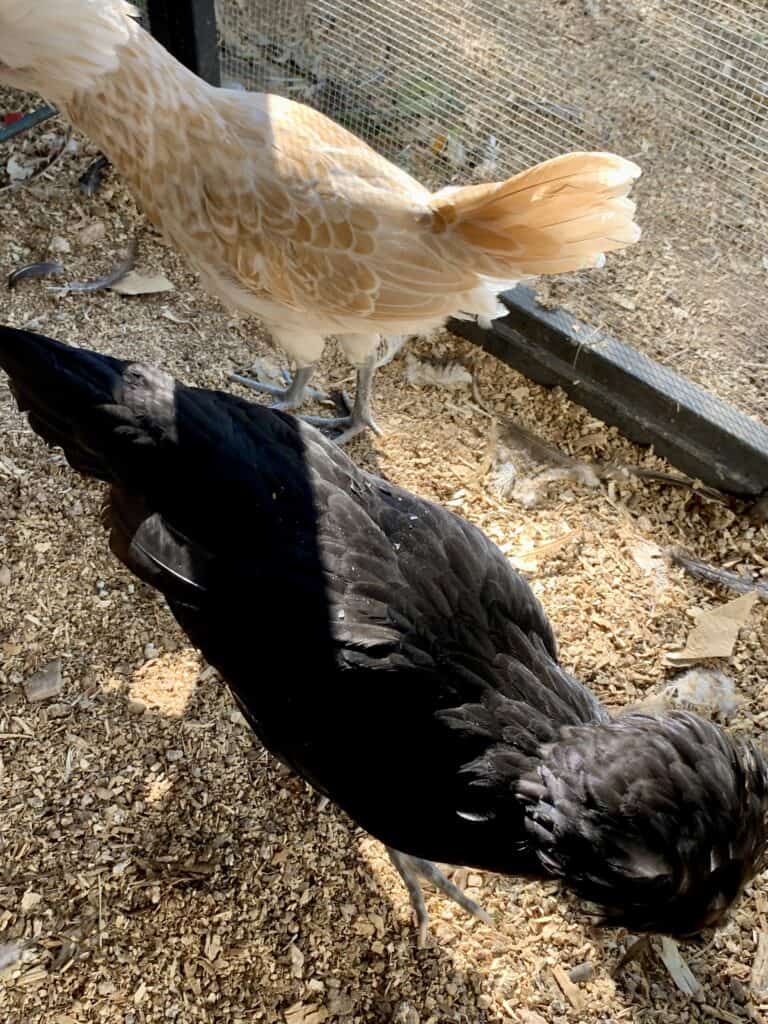
Health
Undoubtedly, everyone is concerned about the health of their chickens and whether they will stay happy and strong. In general, the Polish breed is a healthy bird, but it does run into some breed issues.
For example, you need to watch the chicks carefully because of their bony head prominence. It does not knit together straight away, as similar to the skulls of human babies, and so a peck to the head can kill or maim the chick. At the same time, the adults need to have their crest and beard checked regularly for lice and mites.
The feathers around the face should be trimmed and kept clean so that they can see properly. On that note, experts do not advise trimming around showing season because judges often deduct points.
Besides these basics, the Polish breed of chicken has the same general health problems as the average chicken. Additionally, freezing feathers is a big issue, so make sure they stay warm and dry in the colder months.
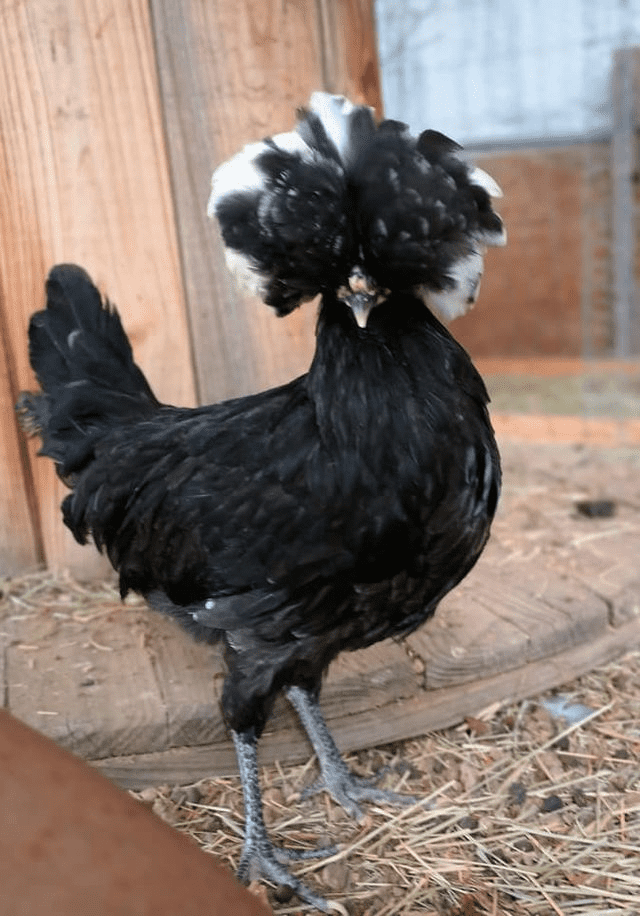
Hierarchy and Dominance
Understanding the hierarchy and dominance of your flock of chickens is essential to keeping the Polish breed happy. Their large crests attract a lot of unwanted attention in mixed flocks, and this leads to pulled feathers, pecking, and unwanted cuts.
Polish breeds are also usually at the bottom of the pecking order because of their docility and vision issues, so it is best to keep them away from aggressive breeds.
Likewise, it is best to try to keep them only with other Polish breeds or a similarly calm breed like the Silkie. Your birds will appreciate it, and you will have fewer problems with bullying and lost feathers.
Friendliness and Aggression
Many people are starting to keep chickens as pets and not just for meat and eggs. This leads many to question just what breeds are friendliest.
So, are Polish chickens friendly? In general, the Polish breed is calm and gentle, so it is great to have around children and other docile breeds like the Silkie chicken.
However, the Polish can be nervy and flighty because of its obscured vision and tendency to be bullied by more aggressive breeds. To avoid scaring your Polish frizzle, you should talk and whistle when approaching and in its presence so that it knows where you are.
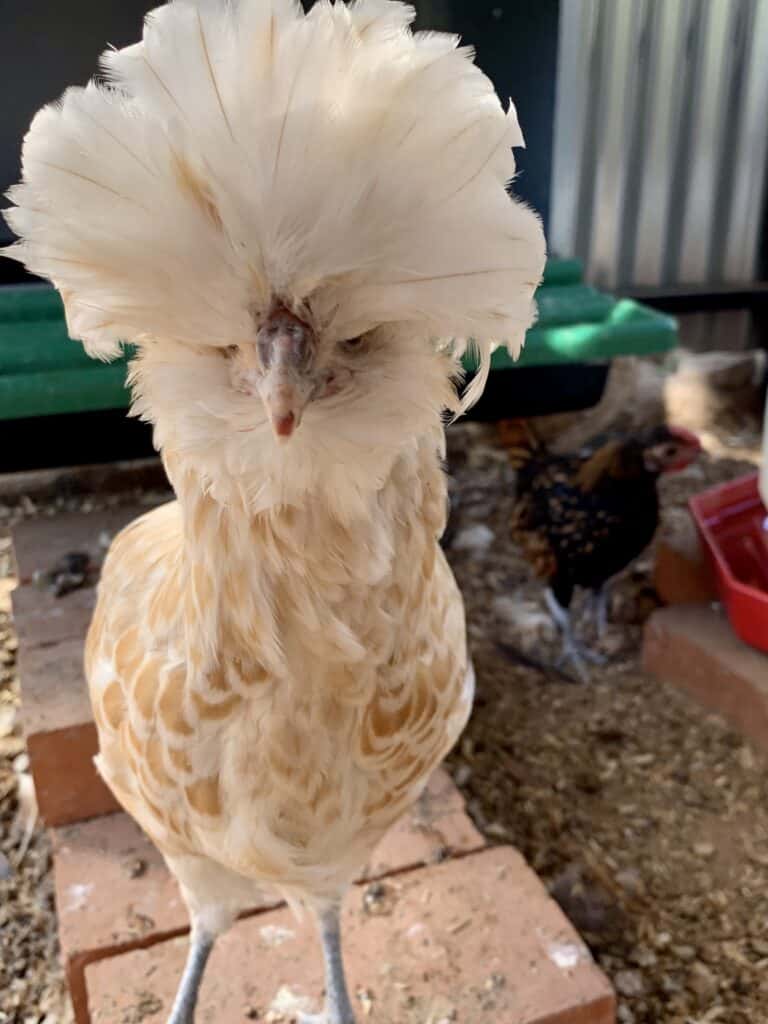
Startled, these birds can run, so try to keep it in an enclosed area, in groups. Lonely or scared Polish frizzle are noisy and will cry out to see if there are other birds around. As you can see from their friendliness, the Polish rooster and hen are not aggressive and will almost always be at the bottom of the pecking order in a flock.
An even bigger problem for these chickens is others will try to pull their head feathers, which leads to a bald and annoyed Polish. However, even when attacked, the Polish chicken lacks aggression and would prefer to be left alone.
Caring for Polish Chickens
Like raising all chicken breeds, they will greatly benefit from fresh air and sunshine. Having the opportunity to be outdoors will help keep them healthy. They love to forage and eat pests. If they can’t free range for part of the day, setting up a chicken run will be great too.
They are inquisitive and like to investigate its surroundings. Some have been known to be climbers, which often results in them becoming trapped in unusual locations and requiring human assistance.
Additionally, the Polish breed of chicken does best in temperate climates. Try to avoid letting them get wet, especially in cold weather. If it gets wet, you need to dry their crests and poufs so that they won’t be uncomfortable.
Make sure you provide a heated environment for cold and damp winters to avoid freezing feathers, hypothermia, and frostbite.
How to Care for a Polish Chicken
If you have decided you want a Polish breed of chicken, you should know that it is considered high maintenance because of its large crests and vision issues. Nonetheless, caring for this breed is simple because it is easy to please and love being social. Here are its needs to consider:
1. Hair Trimming and Bobbling
The crests are prone to lice and mite infestations, and the skin underneath can become infected. The crests can also cause eye irritation, permanent vision problems, and trouble breathing.
Some people put the crest up in a hair bobble to remain clean and tidy without regular trimming. The only catch is you need to make sure the hair bobble is not too tight, as that can hurt the Polish.
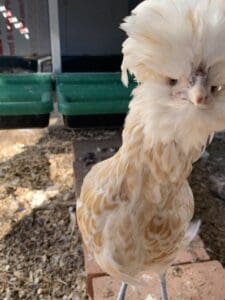
2. Housing
When it comes to housing, mature hens don’t require much. They do well in standard coops but prefer to have features like large nesting boxes, strong walls, and small openings to the outside.
They are timid and like to be close to one another. Each bird needs approximately two feet of space so they can roost and roam around without hitting each other. Some people choose to keep these chickens indoors at all times. If you do this, make sure you purchase a large coop for their comfort.
While the Polish is a hardy bird, it does not like being cold. Make sure the housing has proper insulation, and there are some easy-care features like removable siding.
When it comes to bedding, the Polish loves wood shavings and strongly dislikes sand. Pine needles, sawdust, and newspaper shredding are excellent alternatives if you cannot find wood shavings.
Finally, the housing should be sturdy and easy to clean. You won’t have to collect eggs every day, so don’t worry about accessibility to the nesting area. Just make sure the chosen coop is warm and has access to fresh water.
Housing for Chicks
Polish chicks should spend the first six weeks of their lives in a brooder so that they can be safe and avoid issues like head pecking and chick cannibalism.
Make sure you keep their still solidifying heads safe. All chicks need at least one square foot of space and will appreciate a heat lamp, pine shavings, and plenty of food and water.
After six weeks, feathers will replace the chicks’ baby fluff, and they can enter the regular coop with their parents. Since the hens are not broody, the brooder is a great way to ensure your Polish chicks survive and are comfortable.
3. Food
Having the proper food and water is essential to raising a Polish and any other chicken. You want your birds to have a healthy, nutritionally complete diet, which you can accomplish by giving them laying feed as well as extra protein during the fall.
Also, since it needs to grow extra feathers, it will need more protein in its entire diet. Likewise, since it will molt at one year old, it will require extra protein at that age.
It is recommended you pick a molt-specific feed or add the following supplements to its food:
- Mealworms
- Meat and dairy products
- Shellfish
- Chick feed
- Sprouts
- Nuts and seeds
4. Water
When it comes to providing adequate water, you should make sure the bowls are kept high enough to prevent the crest from falling into the liquid.
In cold temperatures, a wet head is prone to developing ice and leading to many health issues. Wet feathers can also attract lice and mites. Consider getting specialized waterers for improved health and wellness.
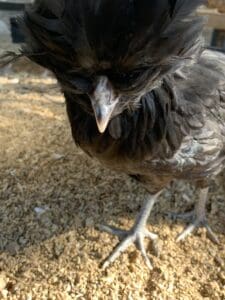
Benefits of the Breed
The overall pros of raising this Polish breed of chicken are:
Great Show Birds
This breed of chicken is a great candidate for a show chicken and has become popular in competitions around the world. If you want to win competitions without spending a ton of money, you can buy a Polish chick for a low cost and then raise it to be ready to show.
Beautiful Plumage
In addition, many people raise this breed because it is a unique addition to any garden or backyard flock. Its tufts are fun to care for, and the Polish enjoys being pet, which makes them happy.
Excellent Pets
They are gentle and enjoy being social and eating pests in a garden. These birds are fun to play with and work well with families. They are excellent to have around children because they are gentle and willing to deal with clumsy hands and affection.
They are also quite noisy and have been known to “talk” to their owners when they are feeling lonely and want some attention.
In addition, they like to be held and cuddled and will tolerate human attention with ease. Many will even tolerate being brushed and kissed on the head.
It is best to have more than one Polish so that they can spend time together and groom one another with the threat of having their feathers plucked. If you want farm-fresh eggs but don’t want to deal with a ton of production, the Polish is an excellent choice because they lay regularly, but not daily.
Negatives of the Breed
There are several reasons why the Polish is used for showings and as a pet and not for eggs or meat.
The Polish is difficult to introduce to a flock with other breeds of chickens, especially if they are active or aggressive. They are low in the pecking order and are small with luxurious feathers and some health issues.
When you care for the Polish, you need to expect infestations of lice, mites, and other common parasites. These will often take root around the crest of the chicken and can cause serious health problems if left unchecked.
If left unattended, you might find your chicken losing large clumps of feathers or experience other health problems. It can also be difficult to determine if the feather loss is due to bullying behavior or pests.
Fortunately, you can easily treat mites and lice by doing the following:
- Providing ample access to dust baths for all the birds in your coop
- Cleaning your coop and living quarters regularly
- Sprinkling diatomaceous earth in the coop
- Monitoring your chickens for signs of infestation
- Maintaining a proper ratio and population of chickens in your coop
Breed’s History
Although Polish chickens have been around for a long time, people are unclear about the exact origin of the breed. One thing to know is Polish chickens didn’t develop in Poland.
One popular theory is that the breed’s ancestors were brought to Central and Eastern Europe by Asian Mongols during the Middle Ages, resulting in their popularity in Poland.
Another common theory is immigrants brought the chicken to Poland after breeding them in Spain and Italy in the late 16th century. Whatever the case may be, the Polish chicken was standardized in the Netherlands and became a European thoroughbred in the 16th century.
The breed has been portrayed time and time again in Dutch and Italian artwork through the 16th and 18th centuries and can be seen in artwork as early as the 15th century.
According to the American Poultry Association, the Polish breed of chicken was introduced to the USA at some point between 1830 and 1840.
Although they are not the best at laying eggs, this crested breed became a favorite among farmers and chicken fanciers who enjoyed their unique poufs and tufts.
In fact, there are many accepted Polish varieties in the American Poultry Association’s Standard of Perfection.
Polish Chicken Breed
Polish chickens are a happy breed. They are docile, friendly, and intriguing. At times they can be anxious and prone to some common health issues like lice, mites, and eye irritation. However, if you take care of their feathers and make sure they have a protein-rich diet, the Polish is a great garden chicken or pet for families.
If you like the appearance of crested chickens, check out Silkie chickens. Also, sometimes the Swedish Flower Hen chicken is crested.
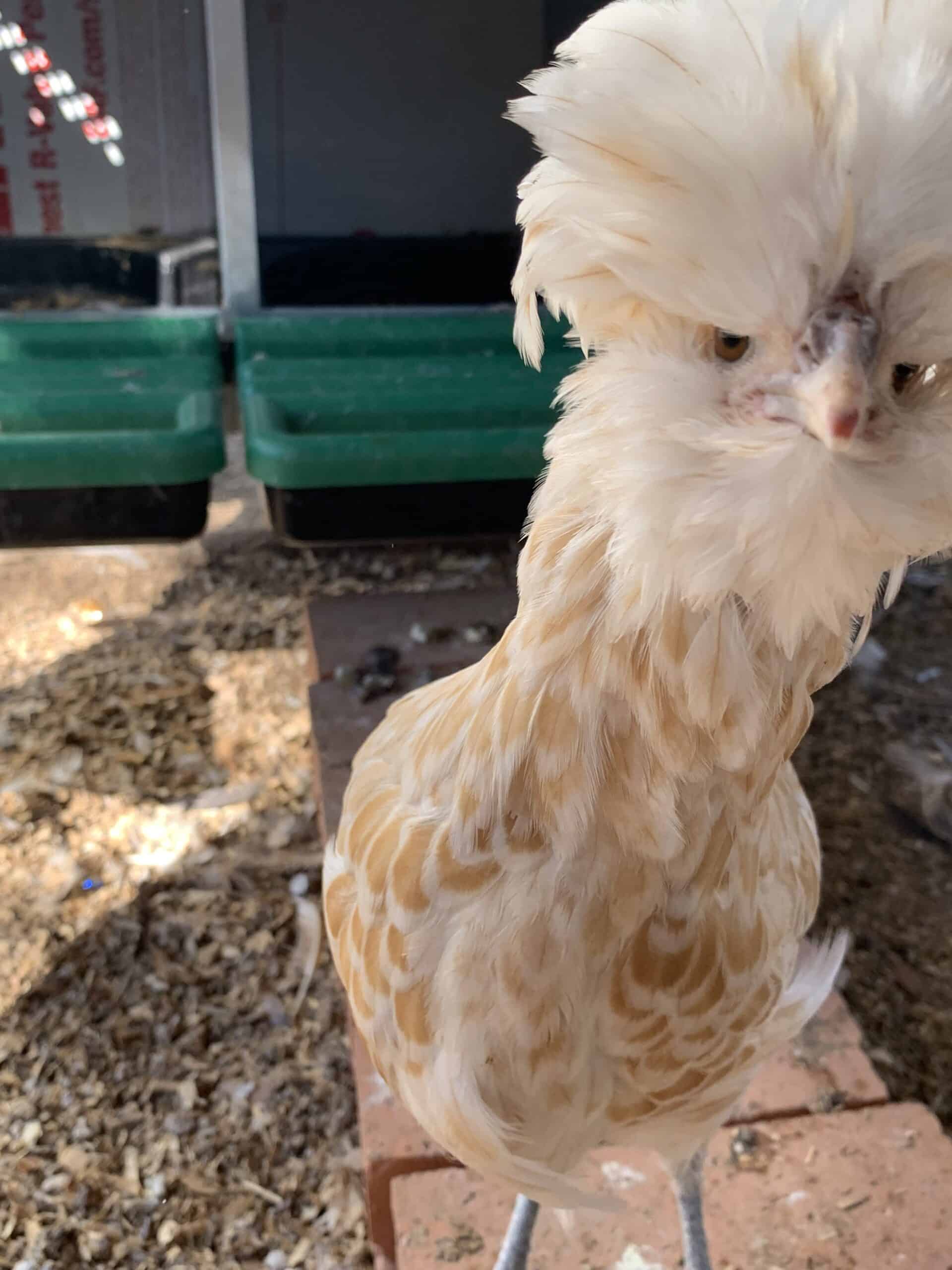
excellent informative article, a great help having just purchased 5 polish chickens.